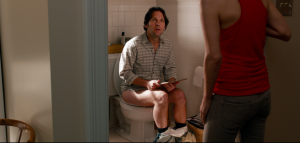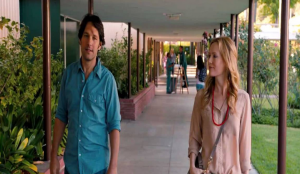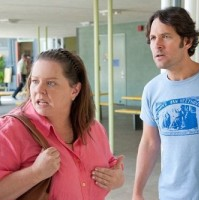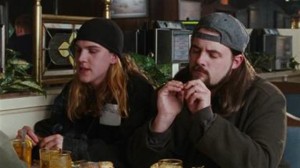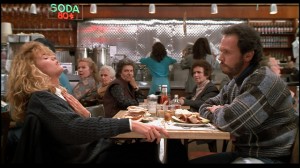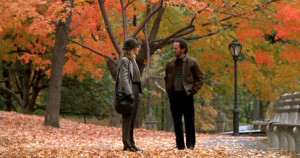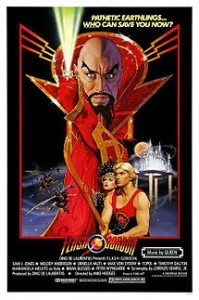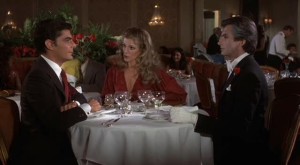Movie Review: About Last Night
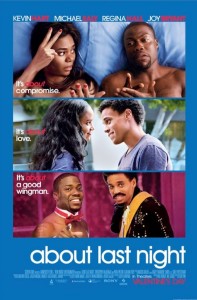 The 1986 Brat Pack romance About Last Night is one of my favorite films. That movie was adapted from the 1970s David Mamet play “Sexual Perversity in Chicago” and starred Rob Lowe and Demi Moore as Danny and Debbie — two young adults trying to make a relationship out of a one night stand. Strong comedic turns from James Belushi and Elizabeth Perkins as Bernie and Joan, the lovers’ best friends, added a great deal of enjoyable humor to the film.
The 1986 Brat Pack romance About Last Night is one of my favorite films. That movie was adapted from the 1970s David Mamet play “Sexual Perversity in Chicago” and starred Rob Lowe and Demi Moore as Danny and Debbie — two young adults trying to make a relationship out of a one night stand. Strong comedic turns from James Belushi and Elizabeth Perkins as Bernie and Joan, the lovers’ best friends, added a great deal of enjoyable humor to the film.
I have watched that 80s film so often that when I saw a trailer recycling its one-liners I was appalled…until I realized that film was a remake. Knowing the original film was dated I was actually happy with the idea of a remake, bringing that movie’s charm to a new generation of young adults. Last year around Valentine’s Day couples again had a chance to talk About Last Night.
I was surprised, however, at how closely this 2014 version hews to the original. The plot is beat-for-beat the same, with many scenes being re-enacted with near-identical dialogue. Some of the slang terms were updated to make the lines feel more modern, but this is the same movie as was done almost 20 years ago.
The biggest difference here is the cast. Perhaps attempting to appeal to a new demographic all four main characters are now African-American. Surprisingly, all that really changed was the characters’ skin color–the names, actions, and attitudes all mirror those of the white actors in the 80s version. They even work in the same jobs as their earlier counterparts. That this cast happens to be African-American is entirely incidental in this film as directed by Steve Pink (Accepted, Hot Tub Time Machine parts 1 and 2).
The characters aren’t living in Chicago any more, but this movie is a clone of the original.
That said, much like Gus Van Sant’s remake of Psycho, you can take the same script and not achieve the same results. As Danny and Debbie, the main couple, Michael Ealy (Think Like a Man and “Slap Jack” in 2 Fast 2 Furious) and Joy Bryant (TV’s Parenthood) simply lack chemistry. I truly believed every scene between Lowe and Moore in the original, with their complex emotions and conflicting desires. Yet in this remake Ealy and Bryant seem to be going through the motions. Each deliver their lines with feeling, but yet I don’t feel the raw heat that worked so well in the first film.
To make up for this the previously supporting characters of Bernie and Joan have been beefed up. Kevin Hart (Ride Along, The Wedding Ringer) is even given top billing in the credits, though his role of Bernie is only slightly larger than Belushi’s original. Still, Hart is a capable comedian and his Bernie is even better than Belushi’s original. Hart may recycle many of the original film’s jokes but his delivery and timing simply make them funnier.
To continue expanding Bernie’s character a new subplot was added focusing on Bernie’s relationship with Joan (Scary Movie‘s Regina Hall). Belushi and Perkins had sexual tension in the original, but here it’s a full-on relationship that is more fun to watch than the movie’s A-plot.
As I just don’t care about this movie’s Danny and Debbie the remake will never supplant the original for me, but thanks to Hart and Hall I give this film a recommend
March 5, 2015 Posted by Arnie C | Movies, Reviews | About Last Night, Comedy, David Mamet, Kevin Hart, Regina Hall, Romance, Sexual Perversity in Chicago | Comments Off on Movie Review: About Last Night
Rob Reiner’s classic romantic comedy “The Sure Thing” 30th Anniversary Edition Blu-ray arrives on home ent. shelves March 24, 2015
Rob Reiner’s Classic 1985 Romantic Comedy
30TH ANNIVERSARY EDITION BLU-RAY™
Starring John Cusack, Daphne Zuniga, Viveca Lindfors and Nicollette Sheridan
Arrives on Home Entertainment Shelves March 24, 2015
From Shout! Factory
 Let’s shift the year 2015 into gear and take a ride down the memory lane with Walter “Gib” Gibson and Alison Bradbury from the quintessential 80’s romantic comedy THE SURE THING, directed by celebrated filmmaker Rob Reiner and executive produced by Henry Winkler. The film stars John Cusack (Say Anything…, High Fidelity), Daphne Zuniga (Spaceballs, One Tree Hill), Viveca Lindfors (Stargate) as Professor Taub and introducing Nicollette Sheridan (Spy Hard). On March 24, 2015, Shout! Factory will release THE SURE THING 30th Anniversary Edition Blu-ray™ on home entertainment shelves. Available for the first time on Blu-ray™, this special anniversary edition is a must have for movie collectors and fans of raucously funny road trips, red-hot romantic comedies and romps through 80’s angst. THE SURE THING 30th Anniversary Edition Blu-ray is priced to own at $24.97 SRP.
Let’s shift the year 2015 into gear and take a ride down the memory lane with Walter “Gib” Gibson and Alison Bradbury from the quintessential 80’s romantic comedy THE SURE THING, directed by celebrated filmmaker Rob Reiner and executive produced by Henry Winkler. The film stars John Cusack (Say Anything…, High Fidelity), Daphne Zuniga (Spaceballs, One Tree Hill), Viveca Lindfors (Stargate) as Professor Taub and introducing Nicollette Sheridan (Spy Hard). On March 24, 2015, Shout! Factory will release THE SURE THING 30th Anniversary Edition Blu-ray™ on home entertainment shelves. Available for the first time on Blu-ray™, this special anniversary edition is a must have for movie collectors and fans of raucously funny road trips, red-hot romantic comedies and romps through 80’s angst. THE SURE THING 30th Anniversary Edition Blu-ray is priced to own at $24.97 SRP.
When college student Walter Gibson (Cusack) gets set up for a date with an incredibly gorgeous blonde (Nicollette Sheridan in her film debut), he’s ready to go to the ends of the earth — or at least across the country — to capitalize on this “sure thing.” Paired up with tightly-wound coed Alison Bradbury (Zuniga) via the campus ride-share program, he heads west for Los Angeles. But as the obstacles begin to pile up, he and Alison begin to form an unexpected bond… and soon Gib must choose between the sure thing and the real thing.
THE SURE THING 30th Anniversary Edition Blu-ray™
Special Features:
• Commentary with director Rob Reiner
• Road to The Sure Thing
• Casting The Sure Thing
• Reading The Sure Thing
• Dressing The Sure Thing
• Theatrical Trailer
1080p High-Definition Widescreen (1.78:1)/DTS HD Master Audio
Color/1985/Running Time +/- 95 minutes
January 7, 2015 Posted by Arnie C | Movies, News | 1980s, Comedy, John Cusack, News, Press Release, Rob Reiner | Comments Off on Rob Reiner’s classic romantic comedy “The Sure Thing” 30th Anniversary Edition Blu-ray arrives on home ent. shelves March 24, 2015
The 40 Year-Old-Critic: This Is 40 (2012)
In The 40-Year-Old Critic, Venganza Media creator and host Arnie Carvalho recalls a memorable film for each year of his life. This series appears daily on the Venganza Media Gazette.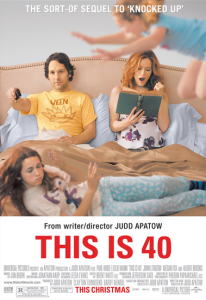
Have you ever wanted to see a movie and yet been afraid to watch it?
It’s an interesting feeling — the allure of a film that should be very good and entertaining, but the anticipation is tainted by fear that I may have an uncomfortable experience. Not that I feel the movie may be bad, but that it could be so good that it makes you a different person after watching it.
As a child I held this fear about many horror movies. From A Nightmare on Elm Street to Hellraiser II, I was scared of what the movie might contain. But as I grew up it wasn’t horror movies that scared me; it was stories about people, and movies that may hold up a mirror and force me to look deep inside myself.
In 2012 the film I feared watching most was This Is 40.
On the surface that may seem absolutely silly. After all, what is there to fear about a comedy, especially a spin off to the easy, breezy stoner sex romp Knocked Up?
The problem lies entirely in coincidence. This is 40 was released in the holiday season of 2012, a time in which those numbers — 4 – 0 — loomed large in my future. This entire review series is a retrospective of my 40 years of watching films, but it ends with me being forced to say, “So… this is 40.”
More, this movie was written and directed by Judd Apatow, best known for his 2005 comedy, The 40-Year-Old Virgin. Though I had watched a few episodes of his TV series Freaks and Geeks, it was through Virgin that I became aware of Apatow’s work.
Clearly he was a funny writer; The 40-Year-Old Virgin had me laughing out loud throughout. But despite being funny and raunchy, there was something about the film that felt real and true. Andy, the sexually-challenged obsessive toy collector played by Steve Carrell, may have been a caricature, but he was also sweet and earnest. By the end of the film he’d gone from wanting sex to wanting true love, and the audience rooted for him. More, his friends all seemed to have more realistic problems; one constantly cheats on his girlfriend, another is obsessed with his ex.
This combination of heart and humor became Apatow’s trademark, and while I didn’t feel his follow-up films Knocked Up and Funny People reached the heights of The 40-Year-Old Virgin, they both were films with a human story surrounded by comedy. Even the films Apatow produced, but didn’t direct or write, often followed that pattern, with Superbad, Forgetting Sarah Marshall, Wanderlust, and The Five-Year Engagement all being character studies as well as comedies.
It was specifically Funny People that made me fear This is 40 the most. That film featured Adam Sandler as a comedian dying of leukemia. While the movie pulled several punches and most of the jokes didn’t hit (like any 21st Century Sandler film), it showed a dramatic weight and had several moments that tugged at the heartstrings and made me contemplate my own death — what would I do if I became terminally ill at a still relatively young age?
Now Apatow was going to set his sights squarely on middle-aged suburbanites. As an Apatow fan I wanted to see the film, but as a man about to turn 40 I feared what I would see.
I have a good life. I love my wife, I have a steady job, we have a nice house, and we travel a lot. Through my podcasts I get to touch the lives of hundreds of thousands of people all over the world, and some of the doors opened by those shows allow me to have experiences many only dream of. I am not unhappy in my life, but any major milestone is a time for reflection. Should I have chased my dreams harder than I did? Should I have become comfortable in my job? Did I compromise too much?
It’s hard to start living a life where you see the clock start ticking the other way, and life starts being gauged by the things you’ll never do instead of the things you’ll do someday. That is being 40 — and I wasn’t sure I wanted to see a movie that would epitomize that experience.
The trailers showed a couple seemingly at a crossroads. The opening scene showed Paul Rudd’s character, Pete, chatting with a friend, Barry (Robert Smigel), confiding that he sometimes fantasizes about his wife’s death and the second wife he may find after.
“God, I can’t wait to meet my second wife,” Pete tells Barry. “I hope she likes me better than this one.”
Yes, it was somewhat amusing but it also was about death. I know too many remarried widows and widowers, and the thought of losing Marjorie was uncomfortable.
Lines then floated from the screen, such as, “I have responsibilities, I can’t afford to sit in my apartment getting baked,” and, “It doesn’t seem like our lives should be this much work.”
Another line that resonated with me; “We’re gonna blink and be 90. We have to make a choice to make things different.”
It then ends with a turnaround, showing Pete’s wife Debbie (Leslie Mann) admitting she also fantasizes about his death.
While the parenting situations portrayed were not ones to which I could relate, these messages of reflection on aging mirrored my inner thoughts to a frightening degree. If I was already undergoing extreme neurotic self-examination, what would I see in the mirror held up by This is 40?
I didn’t see the film in theaters. I eventually rented it on iTunes during a trip; the 30-day rental expired with me never having pushed “play.” Then I set up my Tivo to record it, where it sat for months.
Finally, one night at 3 a.m., I found myself restless and unable to sleep. Though it was a weeknight and I had to work in a few hours, I got up and went into the home theater. It was time to face my fear and watch This is 40, though it was a path I chose to walk alone, intentionally watching when Marjorie was sound asleep.
What did I find in that film? Was it an honest portrayal of 21st century middle-age? Was it a scathing look at modern marriages? Was it going to try to sell me on the trite message that children are the only thing worth living for; a path I intentionally never took?
Nope. All my fear was for nothing — all I got was an incredibly unfunny and poorly written movie.
Despite the title, Apatow didn’t focus on the issues of an aging Generation X. This was not our mid-life crisis version of The Breakfast Club; a cultural touchstone that we could all look at while sadly remembering days gone by. No, This Is 40 is not even attempting to speak to a generation; it is simply a situation comedy with a broad title.
That is fine, and actually I was relieved to not have an uncomfortable movie experience. My dislike of this film is not because it wasn’t what I expected; my dislike is that this is an ugly portrayal of unlikable people in which none of the jokes work.
Pete and Debbie are a married couple who seem to genuinely dislike each other. The death fantasies were not wanderlust; they were manifestations of extreme aggravation. And, honestly, both are right to sometimes hate the other.
Apatow films often feature a man-child in the lead role, and here that character is Pete, a man who keeps chasing his dreams, though he’s about to turn 40. That, in itself, isn’t so bad. Some of his behaviors were even slightly amusing. He sneaks food like a child. He hides out in the bathroom to play on his iPad versus talk to his family. But in this type of character there is a line where you cross from funny into pathological, and Pete crosses that line. He lies to his wife about money, taking their life savings and giving it in chunks to his deadbeat father Larry (Albert Brooks). He also hides his business troubles.
His wife Debbie is no better. If the Apatow male is irresponsible, the counter is the Apatow female — the shrew. Apatow’s real-life wife Mann is often cast in that role, and here she’s the most extreme and horrible version of that character. Vain and neurotic, she leaves her husband to his own devices while she goes out trying to recapture her youth, partying with her young employee Desi (Megan Fox). She flirts with other guys, and there’s a fine line between wanting to feel validated and cheating on your husband; Debbie skirts that line. Most, Debbie discovers she’s pregnant and hides that from Pete.
Looking at these two characters that do whatever they can to not spend time together, who lie to each other versus having hard conversations, I hoped this film ended in divorce. This was not a couple I wanted to see work it out, not even for the children.
Apatow includes scenes of the two working in unison, such as when they have to visit the school principal about an incident with another parent (played by the always one-note Melissa McCarthy). I think the director intended to show that while the couple may fight and struggle, together they are strong. Instead of that, I took away that they are lying, manipulative characters who treat the rest of the world as badly as they treat each other.
It seemed an ugly portrayal — a marriage of convenience and obligation versus love.
Still, I’m not sure this movie had a “plot” so much as it was a loose stringing together of subplots. For instance, Debbie has an employee stealing from her business. It’s a mystery at first, but eventually revealed to be Desi, who is stealing to finance a drug habit. This is supposed to be a revelation that makes Debbie realize young, sexy Desi isn’t perfect and that she should no longer yearn to be in her 20s, but that character turn doesn’t make sense. It really just shows that Debbie is a poor judge of character. More, Desi’s troubles are never examined, and she is cast aside in the film.
Another subplot involves Debbie attempting to reconnect with her wealthy physician father, Oliver (John Lithgow). I thought that subplot was there to provide an “out” for the various financial issues the couple put themselves in, but no, the film offers that solution and then refuses it.
When credits rolled I was relieved that I no longer had to spend any more time with Pete, Debbie, and their dysfunctional family and friends, and I’d have been hard-pressed to tell you the point of the film.
This is 40 is clearly Apatow’s worst directorial effort to date, on par with some of his worst-produced films, notably Wanderlust and The Five-Year Engagement. The jokes fall flat, focusing on such inane topics as an obsession with the TV show Lost. More, the story is non-existent. That could all work if I liked the characters, but the script makes that impossible. Even Rudd, who has oozed charisma in every role I’ve seen, stumbles badly. Usually his charm can make him stand out even when he’s working with sub-par material, but here the most extreme version of his lovable, immature routine comes across as whiny and spoiled.
The worst part of 40 is the length. Perhaps I made a mistake watching the even longer unrated cut, but in a movie where most of the jokes die and the characters have no appreciable arcs, the goal should be to cut as much as possible. Instead Apatow became as self-indulgent as his characters and the film ballooned to more than two hours and fifteen minutes.
I guess I was right for fearing This is 40, but for all the wrong reasons. In the end, I just spent nearly two-and-a-half hours of my last year in my 30s watching a pathetic, unfunny, and unoriginal film.
Now just days away from that milestone birthday, I’ve gotten past my fear — not only of this movie but of that age. The amount of thought given, both through this review series, watching This is 40, and private reflection has shown me that 40 may not be so bad after all. My beard may have a few gray hairs, but I have used this time to build a terrific life.
Being 40 isn’t so bad at all, but This is 40 is miserable.
Tomorrow — 2013 — the final review!
Arnie is a movie critic for Now Playing Podcast, a book reviewer for the Books & Nachos podcast, and co-host of the collecting podcasts Star Wars Action News and Marvelicious Toys. You can follow him on Twitter @thearniec
September 11, 2014 Posted by Arnie C | 40-Year-Old Critic, Movies, Reviews | 2010s, 40-Year-Old Critic, 40-Year-Old Virgin, Comedy, Dramedy, Enertainment, Film, Judd Apatow, Leslie Mann, Movie, Movies, Now Playing, Now Playing Podcast, Paul Rudd, Podcasts, Review, Reviews, This Is 40 | 1 Comment
The 40 Year-Old-Critic: Snakes on a Plane (2006)
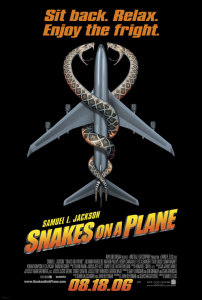 In The 40-Year-Old Critic, Venganza Media creator and host Arnie Carvalho recalls a memorable film for each year of his life. This series appears daily on the Venganza Media Gazette.
In The 40-Year-Old Critic, Venganza Media creator and host Arnie Carvalho recalls a memorable film for each year of his life. This series appears daily on the Venganza Media Gazette.
As I discussed in yesterday’s The 40-Year-Old Critic entry, I began my podcasting career in 2005 with the Star Wars collecting show Star Wars Action News; launched shortly after the release of Star Wars Episode III: Revenge of the Sith.
It had seemed like an easy enough hobby, we just record for 30 minutes each week.
However, the reach exceeded our every expectation, and in February 2006, we realized that recording from home wasn’t enough. All of the new Star Wars action figures and statues that would be released in 2005 had been revealed at Toy Fair International in New York City — and we weren’t there. We had our friends Pete and Chuck from the website Jedi Temple Archives call the show and share the news, but we knew we had missed out.
Pete and Chuck also told about the huge Lucasfilm and Hasbro presence at San Diego Comic-Con. New toys would again be revealed at the summer convention, and we felt Star Wars Action News should be there to cover it.
Marjorie and I had become more experienced con-goers since our first trip to Star Wars Celebration II for the release of Attack of the Clones, but we had never flown to an event. Airline tickets were expensive. Still, we had a show, and we needed the toys. Soon tickets were purchased, press passes obtained, and we were going to SDCC.
Then things got interesting.
As registered press for the convention, Marjorie and I started getting numerous e-mails from various companies seeking exposure. From toymakers to authors to movie studios, we were invited to exclusive events and given opportunities to interview total strangers.
Then came the e-mail that gave us the opportunity to interview Samuel L. Jackson and others for the upcoming film Snakes on a Plane.
I had heard about Snakes on a Plane but paid it little attention. Entertainment Weekly had written several articles about the silly movie with the overly-literal title. From the name alone hundreds of fan websites had sprung up. Despite its premise, the film had a groundswell of good buzz and the film’s producers wanted to capitalize on press coverage at the convention. With Jackson being a vital presence in the Star Wars prequels I thought an interview would certainly be of interest to Star Wars Action News listeners.
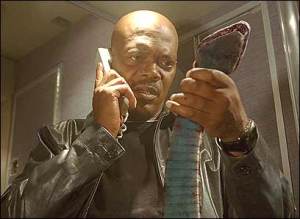
I like to imagine this is Jackson calling his agent wondering how he got on this Plane.
It seemed too good to be true. Jackson was an A-list star; I’d been podcasting for 9 months. I couldn’t believe it would actually happen. I told absolutely no one — after all, if it fell through I didn’t want to be mocked or thought of as a lying braggart. But I prepared: I bought a high-end digital audio recorder and I researched the film to be as informed as possible going in.
Yet the entire event could have been called San Diego Snakes-on-a-Plane Con. On the exhibit floor was a giant booth that was shaped like a snake, yet inside the mouth it had the feeling of a cramped airliner. The music video for Cobra Starship’s “Snakes on a Plane (Bring It)” was omnipresent (and I strained my eye every time it played for a glimpse of Maja Ivarsson’s nipple). We had gone to the convention with some friends who had just discovered the Badger Mushroom song, and so throughout the convention we’d regale each other with the refrain, “Snaaake! It’s a snaaake!” Our friends even brought rubber snakes to the convention as practical jokes.
I was swept up in the utter hype for Snakes on a Plane. I couldn’t wait for them to “Bring it.”
Sure enough, the next thing I knew I was in my first press roundtable interview. Jackson was the biggest star at the event, but it turned out there were four interviews in play. First, we interviewed director David R. Ellis, who I knew from his work on Final Destination 2. The other reporters at the table seemed disinterested and I got to ask a few questions.
Then we talked to the film’s snake wrangler Jules Sylvester. He wore an amazing serpent as he talked about the challenges of dealing with more than 450 snakes on set.
Finally, Sam Jackson visited our table.
Now the other reporters had perked up, and because I was still unaccustomed to the rhythm of the roundtable, I had to work hard to get questions in. I wasn’t entirely new to interviews; I had done many for journalism classes, and interviewed Star Wars collectors and authors on the show. But this was an A-list star. Jackson was there and actually joked with me a bit. It was surreal. He even gave me an autograph on a Star Wars book.
Finally the last interviewee came, Keenan Thompson, who Marjorie knew primarily for his work on Saturday Night Live. I got a couple of questions in there as well.
Leaving the interviews I realized I had far more content than I had thought. While the Jackson interview would be of some interest to Star Wars fans, the rest of the interviews were full of good information, though I knew they had no place on Star Wars Action News. Early feedback from Star Wars listeners was that they did not care for bad language, and so I figured the audience crossover between an R-rated reptile disaster film and Star Wars Action News was minimal.
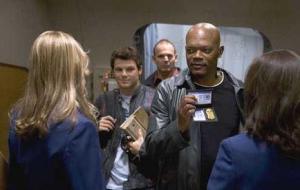
I’m not sure if a movie titled Snakes on a Plane needs more plot than, well, snakes on a plane. Yet this film also gives us a crime story to explain…sort of…how the snakes, and Sam Jackson, got on that plane.
But with four great interviews in the can I decided to start our second podcast, Snakes on a Podcast. It was a limited show, with only five episodes. The first four would lead up to the release of the movie and each would contain one interview. Then, for the fifth show, Marjorie and I would review the movie.
We publicized the show heavily on Star Wars Action News and it got a decent number of downloads. More, anticipation was high for our review; people wanted to know if we thought Snakes on a Plane was worth seeing.
Marjorie and I went to see Snakes opening night in August 2006. We had pre-purchased tickets, the Internet and Comic-Con hype convincing us it would be a sold-out show. It wasn’t.
More, the movie itself wasn’t very good, and we knew it in the theater. It wasn’t terrible, we had seen far worse that year, yet we had hoped for a pulpy B-movie full of laughs and fun. This was long before there was a Sharknado or Piranha 3D, but it was those films’ campy vibe that we hoped Snakes on a Plane would capture. There were moments of that in the film, but they were few and far between. The studio had initially made a PG-13 movie, then went back and added in scenes for the R-rating based off Internet fan demand for the line, “I want these motherfucking snakes off this motherfucking plane.” Those added scenes were what we wanted, that line was legendary, but in between moments of fun were long stretches of stupidity.
You can hear our thoughts, recorded minutes after leaving the theater, in the archived Snakes on a Podcast show. It is the first movie Marjorie and I ever reviewed in podcast form, and is the precursor to Now Playing Podcast, a show we started nine months later.
While the movie failed to meet our expectations, the theatrical viewing didn’t. It was an experience akin to The Rocky Horror Picture Show. While the theater wasn’t packed, everyone there was a built-in fan and the energy of the audience made for a good time. I have watched Snakes once since that theatrical viewing and it is clear that without the fans surrounding us there was little fun to be had.
Snakes on a Plane will always hold a special place in my heart. Not only was it the first time I ever felt like a real reporter for a podcast, it also is one of the last movies to consume San Diego Comic-Con. In the 2000s the complaints were that SDCC was no longer about comics; the fans had come for the movies. That was certainly true in my case. Hollywood studios saw SDCC as an opportunity to push genre movies to greater success, and spent hundreds of thousands, sometimes millions, of dollars at the convention trying to do so.
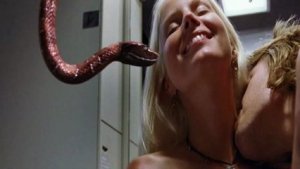
One of the films better, funnier scenes–added later to ensure an R-rating.
Despite the impressive imprint the movie had on the convention floor, Snakes on a Plane fizzled at the box office. Since 2006 a single film has always been pushed at the convention, from Hamlet 2 to Balls of Fury to Scott Pilgrim vs. the World, and they all failed to meet heightened studio expectations. Now it seems film studios have all but abandoned Comic-Con. The giant, custom booths that used to grace the floor are mostly gone. While stars still fly in to host one-hour panels, the convention has morphed into a showcase of genre television shows like Doctor Who, Game of Thrones and Arrow.
Yet each year I hope for another Snakes on a Plane-type experience, another extreme booth attempting to immerse fans in the world of their movie. It may not happen again, but at least I got these motherfucking snakes on this motherfucking Plane.
Tomorrow — 2007!
Arnie is a movie critic for Now Playing Podcast, a book reviewer for the Books & Nachos podcast, and co-host of the collecting podcasts Star Wars Action News and Marvelicious Toys. You can follow him on Twitter @thearniec
September 5, 2014 Posted by Arnie C | 40-Year-Old Critic, Conventions, Movies, Now Playing Podcast, Podcasts, Reviews | 2000s, Cobra Starship, Comedy, Enertainment, Film, horror, Movie, Movies, Now Playing, Now Playing Podcast, Podcasts, Review, Reviews, Samuel L Jackson, San Diego Comic-Con, SDCC, Snakes on a Plane | 1 Comment
40 Year-Old-Critic: Chasing Amy (1997)
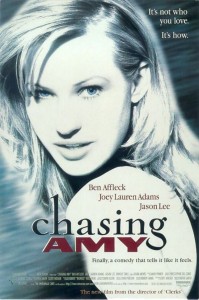 In The 40-Year-Old Critic, Venganza Media creator and host Arnie Carvalho recalls a memorable film for each year of his life. This series appears daily on the Venganza Media Gazette.
In The 40-Year-Old Critic, Venganza Media creator and host Arnie Carvalho recalls a memorable film for each year of his life. This series appears daily on the Venganza Media Gazette.
Kevin Smith is a polarizing figure in cinema. The director certainly has his legion of fans, and having attended several conventions with Smith as a featured guest, it seems those fans are mostly male, mostly under 30, and very willing to connect with his characters; lovable losers such as Clerks’ Randall and Dante (Brian O’Halloran and Jeff Anderson, respectively).
I am not in Smith’s camp, and on Now Playing Podcast I have repeatedly expressed my disdain for his body of work.
Yet allow me in this entry of The 40-Year-Old Critic to praise Smith’s best film, 1997’s Chasing Amy.
Amy (as some fans refer to it) was Smith’s third picture. The director was a Sundance phenom with his black-and-white debut (the aforementioned Clerks) in 1994. It did well in theaters and truly found its audience on video — an audience that included me. Thanks to Quentin Tarantino and Reservoir Dogs, I was paying more attention to indie films, especially those heavily promoted by Miramax. As such, I saw Clerks on VHS and enjoyed it.
As I mentioned in my review of Leaving Las Vegas, around this time in my life I was underemployed and frustrated with my lack of career options, so I related heavily to Dante in Clerks. Plus, I was enraptured by the raunchy jokes. Smith raised the bar on profanity with language that originally earned his film an NC-17 rating. As I did with Beverly Hills Cop before it, I laughed loud and hard at Clerks’ envelope-pushing comedy.
Smith parlayed that success into a studio picture, 1995’s Mallrats. The director spent $6 million of Universal Studios’ money on a movie that barely made one-third that amount. Even as a fan of Clerks I thought Mallrats was too cartoonish, too broad. With new lead duo Brodie Bruce and T.S. Quint (Jason Lee and Jeremy London, respectively), Mallrats tried to replicate the bromance of Clerks in a way that felt forced. More, it seemed Smith’s signature characters of Jay (Jason Mewes) and Silent Bob (Smith himself) would not work in color.
Mallrats would not be Smith’s last failure, but it may be his most fortuitous. First, it established his relationship with Ben Affleck, who had a minor role. Second, after Mallrats Smith returned to his “comfort zone” of small, indie filmmaking. On a $250,000 budget — extraordinarily low but still 10 times that of Clerks — Smith wrote and directed Chasing Amy.
By 1997 I was fully indoctrinated into the Cult of Kevin — as rabid a fanboy as any he’s had. I participated in his online message boards and I watched his first two films regularly (and convinced myself Mallrats wasn’t that bad… it is). Whatever Smith made next I would see. Yet the plot of Chasing Amy I found particularly interesting.

Alyssa (Adams) literally comes between Holden and Banky in this scene.
The film centers around two young independent comic book creators, Holden McNeil (Affleck) and Banky Edwards (Mallrats’ Jason Lee). The best friends find their relationship strained when Holden begins a romance with lesbian comic creator Alyssa Jones (Joey Lauren Adams; Smith’s then-girlfriend), spurring jealousy in Banky.
To me, the film seemed to be jumping on the bandwagon of “queer cinema” which had started to gain steam in the mid 90s. While mainstream Hollywood acknowledged gay characters in movies like Philadelphia and The Birdcage, it was really indie films that brought them to the fore, with such groundbreaking fare as My Own Private Idaho, The Crying Game, and Kiss Me, Guido.
Specifically, I saw in Chasing Amy echoes of Guinevere Turner’s Go Fish — a film Smith acknowledges as inspiration. Sexual preference felt like an exciting new frontier for films to tackle and, having seen all the ones I just mentioned, I likely would have seen Amy even with a complete unknown behind the camera.
I was actually a bit nervous to see Smith tackling LGBT topics. This was a straight man with a penchant for raunchy humor. In Clerks, for example, lead character Dante slut-shamed and dumped his girlfriend after finding out her sexual history. I wondered if Smith would use Alyssa’s sexuality as a source of humor, or to titillate his built-in male audience.
I was happily wrong. Chasing Amy is an exquisite balance of comedy and drama. The start of the film is right in line with Clerks’ humor, as militant black comic creator Hooper X (Dwight Ewell) dissects the racist undertones of the Star Wars trilogy. It was great fun, like a geeky twist on Tarantino’s Like a Virgin deconstruction in Reservoir Dogs. But the humor is nuanced. It’s quickly revealed that not only is Hooper’s rage an act to sell his comics, but he is also a closeted gay male and close friend of Banky and Holden.
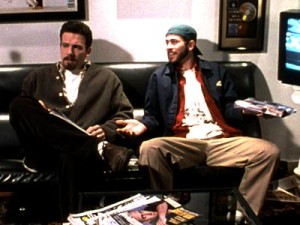
As Holden and Banky, Affleck and Lee created a genuine on-screen friendship. It was one my friends and I related to…until the final twist.
The latter two characters would be familiar to Smith, and not just because both Affleck and Lee appeared in Mallrats. In Clerks, Mallrats, and again here, Smith features the same central duo: immature twenty-something white males with potty mouths. The primary character is more serious, contemplative, semi-neurotic, and dealing with relationship issues. The sidekick is wacky, always given the movie’s funniest lines, but given short shrift in the plot. Here, Holden was our Dante/Quint, and Banky was our Randall/Brodie. The jokes were raunchy and familiar, and the laughs hit hard.
More, Smith seems to know his audience. Any homophobes in the theater get their say through Lee, who spouts gay slurs and stereotypes throughout the film. Featuring gay characters in a positive light, and having Banky spout ignorance, was a subtle way of Smith attempting to educate a more narrow-minded contingent of fans.
Chasing Amy slowly changes tone, though. While all of Smith’s films had dealt with romantic relationships, none had been a romance film. Amy becomes that as Holden befriends unobtainable Alyssa. Their friendship is tinged with longing, and not just on Holden’s side — Alyssa’s feelings for a man make her question her own sexual identity. The scene where Holden confesses his feelings, followed by a rain-soaked argument, is moving and engrossing. There is barely a laugh to be had, and shows a maturity not before seen in a Kevin Smith film.
The film takes continued twists and turns, and jokes keep coming, but Smith had sharpened his humor into a blade, using it to cut the tension of many tense, dramatic scenes. The audience, engrossed in this tumultuous relationship full of self-doubt, would find their laughter a welcome release — the film allowing us to breathe again.
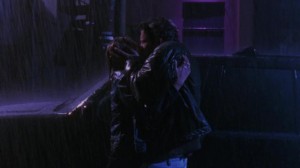
This kiss in the rain was Alyssa finally giving into her feelings for Holden. In most films that would be the end, but here it’s only the beginning of a journey full of self-doubt and jealousy.
While the romantic comedy fan in me was enjoying the Holden/Alyssa relationship, I was also empathizing greatly with Lee’s Banky. I was in my mid-20s and I had lost many friends to their girlfriends. I was all-too-familiar with the pattern of friends who hang out when they’re single, and then don’t return your calls when in a relationship. I saw Banky losing his lifelong friend to a new relationship, and, for the first time ever in a Smith film, I felt bad for the sidekick. Smith had finally created a supporting character with his own arc.
Holden and Alyssa’s relationship eventually hits the rocks when Holden finds out Alyssa was not always gay. The climax (so to speak) comes when Holden, desperate to save his friendship and his relationship, proposes a three-way to both Alyssa and Banky.
That was where the film took things too far. Until that point I felt Smith’s film had portrayed characters acting in ways that felt honest. This twist seemed to be the writer/director choosing to go with a wacky ending over a heartfelt one, or maybe he just wrote himself into a corner and couldn’t find a more earnest resolution.
The group sex idea felt totally outside the realm of Holden’s character. More, that Banky agreed, seemed to me a full character betrayal. I had completely understood Banky’s disappointment with a friend ditching him for a new relationship — it’s a real, common occurrence among single male friends. That Smith chose to write that entire emotion as based in latent homosexuality felt like a missed opportunity — an honest look at friendship was undermined by turning one character into a stereotypical gay male predator.
The film does recover from that moment, with an ambiguous ending that reminded me of The Graduate. Despite my disappointment with the final twist, the movie overall remained an on-screen romance that came across as honest and real. I left the theater entertained and believing Smith would be the next great voice of cinema.
He tried. His follow-up film, Dogma, attempted to analyze religion the way Amy deconstructed relationships, but to lesser effect. While amusing, the picture is scattered and scatological.
But it was with his next effort, Jay and Silent Bob Strike Back, that I realized Smith was not an auteur with things to say, but a writer of increasingly insipid comedy. I first saw Smith speak at a convention in 2001, followed by a preview screening of Strike Back, and I realized he was a more amusing speaker than filmmaker.
History would prove that assumption true, as Smith is now an accomplished podcaster, while the best thing I can say about his post-Strike Back films is that there aren’t many of them.
I have seen all of Smith’s directorial efforts, always hoping to see even a hint of the filmmaker that made Chasing Amy. But from Jersey Girl to Zack and Miri Make a Porno to Cop Out and even Red State, Smith has become a serviceable, but completely unexceptional, director of (mostly unfunny) comedies. I would characterize Smith’s later directing work as on par with Tom Shadyac or Steve Carr. If you don’t know those names, you can look them up, but had Smith not been an indie darling in the mid 90s I don’t think you’d know his name either.
I don’t mean that to say Smith is a one-film-wonder, still coasting on Clerks, because I have gone back and watched his directorial debut — it doesn’t hold up. Jokes that pushed the envelope in 1994 now seem almost tame. More, Clerks is less a film than it is a series of sketches loosely tied together. I loved it when I was the characters’ age and related to their Generation X angst, but it is a movie with limited appeal that is quickly outgrown.
I had hoped that after Cop Out’s critical drubbing Smith might — as he did after Mallrats’ failure — return to his roots and make more personal films. That hasn’t happened. While he has done more low-budget films, such as Red State, it appears the filmmaker who made Chasing Amy is gone forever.
It is a shame. With Chasing Amy Smith showed himself to be a talented writer who could balance both comedy and drama with equal measure. It remains a go-to film when I want to laugh, one of the most honest romances caught on screen, and a progressive view of LGBT characters in cinema. Yet it’s the only Kevin Smith film I can recommend.
Tomorrow — 1998!
Arnie is a movie critic for Now Playing Podcast, a book reviewer for the Books & Nachos podcast, and co-host of the collecting podcasts Star Wars Action News and Marvelicious Toys. You can follow him on Twitter @thearniec
August 27, 2014 Posted by Arnie C | 40-Year-Old Critic, Movies, Now Playing Podcast, Podcasts, Reviews | 1990s, 40-Year-Old Critic, Ben Affleck, Chasing Amy, Comedy, Comic Books, Comics, Drama, Enertainment, Film, GLBT, Jason Lee, Kevin Smith, Lesbian, Movie, Movies, Now Playing, Now Playing Podcast, Podcasts, Review, Reviews, Romance, Romcom | 2 Comments
40 Year-Old-Critic: When Harry Met Sally (1989)
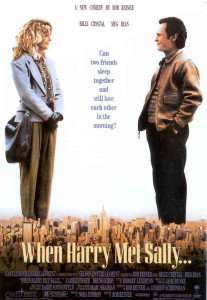
In The 40-Year-Old Critic, Venganza Media creator and host Arnie Carvalho recalls a memorable film for each year of his life. This series appears daily on the Venganza Media Gazette.
On Now Playing Podcast my co-hosts Stuart and Jakob often joke about my affinity for romantic comedies, or “RomComs.” I don’t mind the jokes. After all, it does seem that I tend to go to this lighthearted genre whenever discussing works of actors and filmmakers.
A History of Violence star Maria Bello? First saw her in Coyote Ugly and loved her in The Cooler.
I researched the work of The Wolverine director James Mangold by watching the atrocious Kate & Leopold.
Even mo-cap pioneer Andy Serkis — we actually see his face in 13 Going on 30.
The list goes on and on. I never analyzed my proclivity for these films, but the repeated jesting had me reflect a bit on why I spent time watching them in the first place. It quickly became clear that I chose to see those movies and more because of When Harry Met Sally.
When Harry Met Sally was released in the summer of 1989, which, at that point, might have been the biggest moviegoing summer in Hollywood history. Films like Star Trek V, Indiana Jones and the Last Crusade, Batman, Ghostbusters II, and Back to the Future Part II were all unleashed within weeks of each other.
With these blockbuster heavy-hitters on the calendar, Rob Reiner’s romantic comedy was not the No. 1 film on my “must see” list, but it was up there.
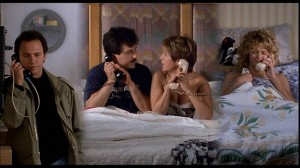
Crystal, Kirby, Fisher, and Ryan engage in 4-way split-screen action.
Part of the draw was the talent involved. I had liked Meg Ryan in Innerspace, and, although I was too young to appreciate the genius of Soap, Billy Crystal had really impressed me with Throw Momma from the Train.
But the biggest draw was Reiner. While I grew up watching “Meathead” on All in the Family, I’d already come to respect him as a director after seeing Stand by Me, The Princess Bride, and even the John Cusack comedy The Sure Thing.
Also, if I’m going to be completely honest, there was another big draw: Sex.
I was in my early teens and dating was a frustrating, confusing experience. I was also learning about sex through government-mandated public school health class as well as… extracurricular materials. As a boy desperately wanting to gain insight into the female brain, this film seemed like a wealth of knowledge.
The trailers teased wise phrases such as “Men and women can’t be friends, the sex part always gets in the way.” Was that true? It boggled my adolescent mind to ponder.
And there was the clip of Meg Ryan performing Sally’s fake orgasm in Katz’s Delicatessen. Yeah, I really wanted to know more about that!
Getting into the theater was a tricky proposition for someone three years shy of the 17-year-old threshold for R-rated films. I eventually convinced my prudish 21-year-old sister Michelle and her husband to take me.
I know that at 13 I didn’t get all the jokes or understand the subtle nature of some of the humor (I also totally didn’t recognize “Princess Leia” Carrie Fisher as Sally’s best friend Marie). Still, I was taken by this film and its world.
Crystal was funny and salacious as Harry. I was won over by this libidinous lothario early on, during the car ride when Harry propositions Sally despite the fact that he’s dating her best friend. Crystal’s timing is spot-on. In the hands of another actor this type of introduction could have alienated the audience, but Crystal’s light hearted delivery, his sparkling eyes, and his disarming smile made Harry the type of character men could root for and women could come to love.
As Sally, Ryan gave the performance of her life. I developed a major crush on Sally and, due to this, I saw most of Ryan’s work. The success of this film made her a hot property, but from Flesh and Bone to I.Q. to The Doors, no performance she has ever given comes close to matching the one she gives here.
I believe part of this is because of the way Ryan threw herself into the role, right down to the deli orgasm scene. While some actresses may have shied away from such an extreme moment, this scene was actually Ryan’s idea. With physical comedy, self-effacing stumbles, and great delivery, she gave her all to When Harry Met Sally.
More, I think her co-stars, primarily Crystal and Bruno Kirby, were so amazing that Ryan’s game was elevated.
Thanks to the performances from the two leads and a script by Nora Ephron, Reiner created the perfect romantic comedy; one that appeals equally to men and women. The movie delicately balanced the two points-of-view and at no point while watching When Harry Met Sally did I feel I was watching a “chick flick.” To me it was just a comedy film.
Not only did this film make me fall in love with Sally; I fell in love with New York City. This was the first time I’d seen New York truly romanticized on screen. Sure, Ghostbusters, Splash, and Short Circuit 2 were among the many movies set in the Big Apple, but this film truly drove home to me the differences between New York and other cities where I’d spent considerable time, such as Chicago or Fort Myers, Florida. The use of cabs for transportation, the unlikely experience of running into old acquaintances in a city with 8 million residents, the difficulty of taking home a Christmas tree in a town that relies on public transportation — I saw it all for the first time in When Harry Met Sally. This was the first movie that I realized to be as much about a place as the people.
Reiner deserves so much praise for the way he structured the film; using holidays to show the passing of time, the split-screens during the four-way phone call, the rapid-fire quips — honestly, I could gush about this film for pages. It is one of those movies that just came together and made on-screen magic.
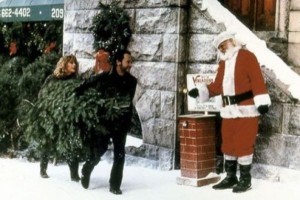
When Harry Met Sally is the perfect movie to watch between Christmas and New Year’s–a perennial holiday favorite.
This was my first foray into truly adult comedy, as compared to the Eddie Murphy comedy that just used adult language. When Harry Met Sally has adults dealing with issues of age, marriage, and commitment; and doing so in a funny way.
I left the theater still pondering the question of whether men and women can be friends; but I was certain that, through Sally, I’d gotten a glimpse into the workings of the fairer gender. I certainly didn’t know all I needed to know, but I felt that I’d been educated (through the film’s female perspective) as well as entertained (by the film’s male point of view).
I wanted to know more, and I wanted to laugh as hard as I did in that theater. Because When Harry Met Sally was such a success, the comedies of the 1990s and 2000s kept copying Reiner’s formula, and I watched dozens of them hoping to feel the same as I did in 1989.
I followed Ryan to French Kiss, Sleepless in Seattle, Addicted to Love, and many more hoping to see, but never finding, the magic she possessed as Sally. Only You’ve Got Mail came close.
I also followed Billy Crystal to the forgettable Forget Paris, but enjoyed his comedy more in City Slickers and Analyze This.
When neither Crystal nor Ryan repeated their success I tried to find this type of on-screen chemistry with other known actors. From Sandra Bullock and Bill Pullman in While You Were Sleeping, to Nicholas Cage and Bridget Fonda in It Could Happen to You, to several Friends stars in films best forgotten, I watched them all.
Most of them were terrible.
Not only did these movies lack the insight and wit of When Harry Met Sally, the genre itself slowly degenerated before my eyes. Initially the films would try to replicate Reiner’s delicate balance of romance and comedy, but in time they changed to focus far more on the romance, less on the comedy, becoming base female wish fulfillment. By the mid-90s the vast majority were, indeed, the “chick flick RomComs” that Jakob taunts me for watching. There were a few gems in the bunch, such as The Wedding Singer, There’s Something About Mary, Bridget Jones’ Diary and The 40-Year-Old Virgin, but, by and large, they were junk that left me bored.
But if I was not entertained, was I educated? Did this deep dive into the world of female-targeted cinema give me insights into women? Well, in the past 25 years I’ve learned a lot, and mostly it’s that everyone is a unique individual. My quest to learn some magic secret about “all women” was doomed to fail because each woman is her own person. I learned that not through film, but through dating and, eventually, marriage.
I also learned the answer to Reiner and Ephron’s main question — yes, men and women can be friends. The best marriages are those where the two are friends. I feel lucky to have that where my best friend is my wife.
So maybe When Harry Met Sally taught me something after all.
Tomorrow: 1990!
Arnie is a movie critic for Now Playing Podcast, a book reviewer for the Books & Nachos podcast, and co-host of the collecting podcasts Star Wars Action News and Marvelicious Toys. You can follow him on Twitter @thearniec
August 19, 2014 Posted by Arnie C | 40-Year-Old Critic, Movies, Now Playing Podcast, Podcasts, Reviews | 1980s, 40-Year-Old Critic, Billy Crystal, Bruno Kirby, Carrie Fisher, Comedy, Meg Ryan, Movie, Movies, Now Playing, Now Playing Podcast, Orgasm, Podcasts, Review, Reviews, Rob Reiner, Romance, Romantic Comedy, Romcom, When Harry Met Sally | Comments Off on 40 Year-Old-Critic: When Harry Met Sally (1989)
40 Year-Old-Critic: Beverly Hills Cop (1984)
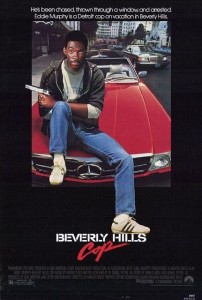 In The 40-Year-Old Critic, Venganza Media creator and host Arnie Carvalho recalls a memorable film for each year of his life. This series appears daily on the Venganza Media Gazette.
In The 40-Year-Old Critic, Venganza Media creator and host Arnie Carvalho recalls a memorable film for each year of his life. This series appears daily on the Venganza Media Gazette.
For as long as there have been movies, there have been movie stars.
As early as the 1910s film studios realized familiar faces could bring in audiences. From Florence Lawrence to Humphrey Bogart, Marilyn Monroe to Charlton Heston, Tom Cruise to Will Smith, the right movie star can trump story, script, and even production value and turn terrible films into box office gold.
As a child, though, I didn’t understand the concept of following actors; instead, I followed characters. I wanted to see the next film with Kermit the Frog, Luke Skywalker, or God. I wasn’t thinking about Jim Henson, Mark Hamill, or George Burns.
That changed in 1984 when I found my first cinema idol, the man I wished I’d grow up to be.
Much to my parents chagrin, that man was Eddie Murphy.
I was not much of a Saturday Night Live fan when I was young. While I didn’t have a set bedtime, midnight was a bit later than I usually stayed up. I’d seen the show a few times but I was neither a fan, nor did I even know the comedians in the cast.
But in 1984 I had become a cinephile, seeing dozens of films in theaters and countless more on VHS. In addition to the standard kids fare, like Ghostbusters and The Neverending Story, my tastes were starting to evolve. Thanks to Siskel & Ebert I was asking my parents to take me to see some movies where I was clearly not the target audience, such as Amadeus, as well as the fairly risque Johnny Dangerously (I saw it in theaters once… once).
My older sister Susan, home from college for Christmas break, witnessed my maturing interest in film and felt there was one movie phenomenon I was totally missing: Beverly Hills Cop. It had been out a few weeks and had started to build amazing buzz. Critics loved it, and it was topping the box-office.
 But it had a hard-R rating, with nudity, intense gun violence, and more curse words than I could count. My parents were fairly lax about what media I consumed (a year later they’d let me rent Revenge of the Nerds knowing full-well what I was about to see), and Susan decided it’s better to beg forgiveness than to ask permission. So she took me to the mall, ostensibly to Christmas shop, but, in fact, to see my first R-rated film: Beverly Hills Cop.
But it had a hard-R rating, with nudity, intense gun violence, and more curse words than I could count. My parents were fairly lax about what media I consumed (a year later they’d let me rent Revenge of the Nerds knowing full-well what I was about to see), and Susan decided it’s better to beg forgiveness than to ask permission. So she took me to the mall, ostensibly to Christmas shop, but, in fact, to see my first R-rated film: Beverly Hills Cop.
I was absolutely awestruck. I had never seen a movie as extreme as this.
The story, originally intended to star Sylvester Stallone, followed fast-talking Detroit police detective Axel Foley’s trip to Los Angeles investigating the murder of his childhood friend. But the cop becomes the criminal when clues point to wealthy art dealer Victor Maitland, and police actually authorized to act in the Beverly Hills jurisdiction try to reign in Foley’s unorthodox inquest. The result is quite a bit of 80’s action, as well as the usual fish-out-of-water jokes, as Foley works both with and against the Beverly Hills Police Department in trying to bring his friend’s killer to justice.
The violence excited and frightened me. I’d seen guns on the big (and small) screen, but before Beverly Hills Cop I’d never seen a man shot twice in the head; chunks of the victim’s skull falling to the carpet. I’d seen car chases on Dukes of Hazzard and other shows, but none had the metal carnage like the truck chase in the film’s opening minutes. I’d seen machine gun shootouts on The A-Team, but those didn’t actually have people falling dead from the wounds.
Then there was the language. My parents had been known to use a few choice words but never had I heard expletives used in this way. Murphy had gone beyond just cursing, he turned his Beverly Hills Cop dialogue into a virtual tone poem of profanity. So shocked was I that I completely misunderstood the main character’s name — in my mind Murphy starred as “Asshole Foley”, with every single character referring to him by that descriptive term. Given the way he acted, who could blame them?
Yet, the entire picture was set to a light, pop score. The synth tones of Harold Faltermeyer ran throughout, interrupted only by chart-topping hits by The Pointer Sisters, Glenn Frey, and Vanity. I was never afraid or scared, I was enthralled. My adrenaline was pumping, I was rocking, and, most importantly, laughing. I had never before experienced a film that felt subversive, like I was seeing a peek into the adult world, hearing how they talked with no kids around.
I loved it.
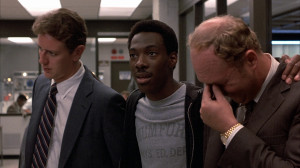 More, I loved Eddie Murphy. The comedian is in nearly every frame of Beverly Hills Cop and his energy is infectious. Here the actor perfected the con-artist persona he previously used on the small screen, as well as in 48 Hours and Trading Places. No matter how dangerous the situation, I knew Murphy would be able to talk, joke, or shoot his way out of it. I don’t recall ever laughing quite as hard as I did in that theater watching Axel Foley stick a banana up the tailpipe of that car staked outside his hotel.
More, I loved Eddie Murphy. The comedian is in nearly every frame of Beverly Hills Cop and his energy is infectious. Here the actor perfected the con-artist persona he previously used on the small screen, as well as in 48 Hours and Trading Places. No matter how dangerous the situation, I knew Murphy would be able to talk, joke, or shoot his way out of it. I don’t recall ever laughing quite as hard as I did in that theater watching Axel Foley stick a banana up the tailpipe of that car staked outside his hotel.
I walked out of the theater ecstatic. I wanted to see more. For the first time in my life I was starstruck and wanted to see everything Eddie Murphy had done or would do.
I made it a point to stay up late that week and watch Murphy host Saturday Night Live (his “White Like Me” sketch still makes me laugh). Quickly I went to the video store to rent his previous two hits. And I went opening weekend, again with Susan, to see The Golden Child.
Yes, I even bought the novelization to try and quell my excitement two years later for Beverly Hills Cop II.
I started buying Eddie Murphy comedy albums and watching Raw and Delirious. Through those specials I connected with Murphy, because I realized I idolized him as Murphy in his youth idolized Richard Pryor. I even found myself trying to tell Eddie Murphy-style jokes, and, for a time, flirted with the idea of doing stand-up comedy. I didn’t have much of a sense of humor as a child; I developed it in my teen years and Murphy was my teacher.
My parents were not overly fond of their son’s new hero. The string of profanity that emitted from our family room television would prompt my mother to use a few choice words of her own.
I didn’t see it the way she did. Murphy’s complete ownership of his vocabulary allowed me to see the power words have without fear. As a young kid I would curse for the wrongness of it, but Murphy helped me see that cursing punctuates language with an emphasis that nothing else can emulate.
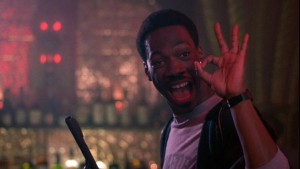 Older generations would state that swearing was for the dumb; Murphy showed me the truly intelligent know-how to wield every word for maximum impact. Some listeners have complained about the language we sometimes use on Now Playing Podcast, but I would not change a syllable. I believe the complete use of the English language allows me to express myself uniquely and clearly. I learned that from Murphy’s ad-libs and stand-up routines.
Older generations would state that swearing was for the dumb; Murphy showed me the truly intelligent know-how to wield every word for maximum impact. Some listeners have complained about the language we sometimes use on Now Playing Podcast, but I would not change a syllable. I believe the complete use of the English language allows me to express myself uniquely and clearly. I learned that from Murphy’s ad-libs and stand-up routines.
I wasn’t the only one to fall under Axel Foley’s influence. Beverly Hills Cop became the first R-Rated film — and the first comedy — to gross more than $200 million at the box office. That was a very exclusive group well into the 1990s.
Murphy even beat fellow Saturday Night Live alums Bill Murray and Dan Aykroyd, with Cop making more money in 1984 than Ghostbusters.
I must admit that Ghostbusters, with its lighthearted comedy, special effects, and giant Marshmallow Man, left a cinematic legacy that may be greater than Beverly Hills Cop. The Ghostbusters formula is aped to this day with films like R.I.P.D., Men in Black, and Evolution. There’s even a director signed for Ghostbusters III.
On the other hand, I don’t feel Murphy has aged as well. While his box-office mojo reigned for many years, even as a child I knew his follow-up films, The Golden Child and Beverly Hills Cop 2, didn’t measure up to his first star vehicle. While Coming to America was a brief return to form, it was also the last time I loved an Eddie Murphy film.
After The Distinguished Gentleman I realized his films had dropped significantly in quality, but due to my childhood devotion, I saw every film Murphy released through the 1980s and 1990s (yes, even Holy Man and Life). I watched every new Murphy movie hoping to laugh as hard as I did in Beverly Hills Cop and Coming to America. I finally gave up in 2001, I could not abide Pluto Nash.
But Murphy was the first movie star to impact my viewing habits. For that reason, even though I should know better, I continue to cross my fingers and hope the “Asshole Foley” I know and love will be back in Beverly Hills Cop IV.
Arnie is a movie critic for Now Playing Podcast, a book reviewer for the Books & Nachos podcast, and co-host of the collecting podcasts Star Wars Action News and Marvelicious Toys. You can follow him on Twitter @thearniec
August 14, 2014 Posted by Arnie C | 40-Year-Old Critic, Movies, Now Playing Podcast, Podcasts, Reviews | 1980s, 40-Year-Old Critic, Action, Beverly Hills Cop, Comedy, Eddie Murphy, Enertainment, Film, Ghostbusters, Movie, Movies, Now Playing, Now Playing Podcast, Podcasts, Review, Reviews | 6 Comments
40 Year-Old-Critic: Popeye (1980)
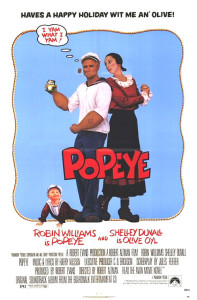 In The 40-Year-Old Critic, Venganza Media creator and host Arnie Carvalho recalls a memorable film for each year of his life. This series appears daily on the Venganza Media Gazette.
In The 40-Year-Old Critic, Venganza Media creator and host Arnie Carvalho recalls a memorable film for each year of his life. This series appears daily on the Venganza Media Gazette.
What, you thought The Empire Strikes Back was a given for 1980? Absolutely not! Let me explain.
1980 is a special year for me because it is the first year I can actually remember seeing movies in theaters. I have vivid recollections of my mother taking me to see The Empire Strikes Back on a hot summer day while weekending in Chicago, and I remember going to see Superman II when it opened at our local mall. And I remember later that year my sister Susan taking me to see the Robin Williams “comedy” Popeye, and sadly this is the moviegoing experience I remember best of all.
As a child I loved cartoons. Mostly, I was interested in superheroes like Superman, but I watched the Bozo show religiously and it featured a variety of cartoons, including Tom and Jerry, Mighty Mouse, and Popeye. I consumed this animated fare as part of a daily television diet.
My TV viewing was not confined to mornings, I was also starting to watch prime time shows. Being the youngest child in the house I rarely choose what shows were on our one television. Occasionally, when I was alone, I’d get to see Dukes of Hazzard or The Incredible Hulk. But most nights I watched whatever my older sisters wanted to see.
Their tastes ran to sitcoms of the day: Happy Days, The Jeffersons, Three’s Company,The Facts of Life, and my absolute favorite, Mork & Mindy. Robin Williams’ character, along with his colorful costumes, kept my attention for the full half-hour every Thursday night.
So, Williams as Popeye? It had to be a no-brainer for Susan to take her kid brother to that movie. To this day, the experience of seeing that film is burned into my brain.
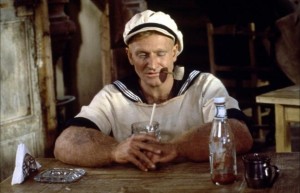
I yam what I yam…a bad movie.
My first reaction to this dirty, ugly picture was, “This isn’t my Popeye!” I wasn’t sure what had happened to the character I loved from The Bozo Show, but as shown on-screen “our hero” Popeye was beaten down and disavowed. His every scene seemed to be a boring exercise in humiliation. Worst, this Popeye hated spinach! A recent rewatch made it clear that the ingestion of that canned plant is the character’s arc — his origin story — but to a 6-year-old it seemed this movie didn’t know the first thing about the cartoon I loved. It lacked the crazy, fast-paced antics of the animated show and replaced it with warbled songs sung by Shelley Duvall and Robin Williams, neither of whom should ever be allowed to sing again (Aladdin aside). It seems even Williams was embarrassed during the making of the movie–he looks depressed in nearly every scene.
And it wasn’t just Williams, it was everyone. As Pappy, Ray Walston was a frightening character who denied Popeye’s parentage. Bluto was a bully that seemed comical in animation, but when personified in the flesh his hairy bulk repulsed me.
At 6 years old I did not yet possess the vocabulary to express how this movie made me feel. I did not know the meaning of words like “abrasive” or “grimy.” I couldn’t properly express that Popeye lacked the fun, spirited tone of the cartoon, and that its rundown river-town setting made me feel like I needed a hot bath. I didn’t just experience disappointment, I had a feeling of utter betrayal — and not just by Popeye. I wasn’t that big of a fan where an inaccurate on-screen portrayal would scar me.
No, I felt betrayed by cinema.
Up until this point in my life I’d had a magical experience every time I had gone to the movies. I’d seen Yoda teach Luke Skywalker about good and evil. I’d listened to Muppets sing and loved it. I’d seen God in the guise of George Burns. I’d been enthralled as Mickey Mouse made brooms dance. I’d believed a man could fly! I hadn’t seen a lot of movies in theaters at this age, but each one seemed hand-picked for maximum enjoyment. I thought the movie theater was a place where only good things happened.
Seeing Popeye made me realize, for the first time, that a movie could be really, truly terrible. In some ways, it was the death of my childhood innocence.
I insisted my sister take me back to the movies a week later to wash the taste of spinach out of my mouth. She picked a film I hadn’t heard of, Flash Gordon. Again, I thought I would be seeing another cartoon hero come to life (I’d mistaken it for the DC Comics hero, The Flash).
It was like a one-two punch, Popeye and Flash Gordon. I’d never look at movies the same again.
From the moment I walked, shell-shocked, out of that mall theater something inside me changed. My trust in the silver screen was broken. It would take many years for me to fully comprehend the enormity of that concept — that choices had to be made where I spent my money and time — but it all started with what surely must be director Robert Altman’s worst picture.
I am now about to turn 40, but inside I’m still a 6-year-old every time I go into a theater. I still hope every movie I watch — especially every theater-going experience — will be magical and wondrous. And I still feel betrayed when I’m instead given something as disastrous as Popeye or Aliens vs Predator.
At least now I can channel those memories and spare others from the letdown I experienced. As a critic on Now Playing Podcast I, hopefully, can warn people when there’s a Popeye at the multiplex. Also, as an adult, I can now fully put into words those negative feelings I had as a child.
Thinking now about 1980, I realize so many films I love today were released that year: The Empire Strikes Back, The Blues Brothers, Raging Bull, Ordinary People, and, of course, the original Friday the 13th. I have memories of seeing them all, but none are as vivid as that horrible Saturday when I saw Popeye.
Next — 1981!
Arnie is a movie critic for Now Playing Podcast, a book reviewer for the Books & Nachos podcast, and co-host of the collecting podcasts Star Wars Action News and Marvelicious Toys. You can follow him on Twitter @thearniec
August 10, 2014 Posted by Arnie C | 40-Year-Old Critic, Comic Books, Movies, Now Playing Podcast, Podcasts, Reviews, Television | 40-Year-Old Critic, Bluto, Cartoon, Comedy, Flash Gordon, Movie, Movies, Now Playing, Now Playing Podcast, Olive Oil, Popeye, Review, Reviews, Robin Williams, Shelly Duvall | 4 Comments
40 Year-Old-Critic: Love at First Bite (1979)
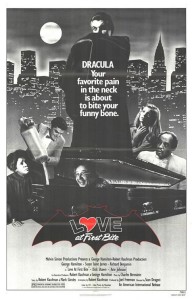 In The 40-Year-Old Critic, Venganza Media creator and host Arnie Carvalho recalls a memorable film for each year of his life. This series appears daily on the Venganza Media Gazette.
In The 40-Year-Old Critic, Venganza Media creator and host Arnie Carvalho recalls a memorable film for each year of his life. This series appears daily on the Venganza Media Gazette.
It’s not easy to choose a favorite film from 1979 — so many of that year’s films have influenced my life in one way or another, from The Muppet Movie, which solidified a love for the older-skewing Muppets, to Alien, which scared the pants off me (and Sigourney Weaver), to The Jerk (which may be Steve Martin’s finest ludicrous performance). And I cannot leave out Francis Ford Coppola’s mad masterpiece Apocalypse Now, which is certainly the most engaging and best-made film from 1979.
But while I always enjoy getting lost in the jungles of Coppola’s Vietnam, I didn’t see the film until adulthood, and it hasn’t shaped my life or my views.
The movie that did was a little George Hamilton horror spoof, Love At First Bite. The story tells of Dracula (George Hamilton) coming to (then) modern-day New York City to find his true love Mina Harker, who has been reincarnated as supermodel Cindy (Susan Saint James). His quest is thwarted by Cindy’s psychiatrist boyfriend Jeffrey Rosenberg (Richard Benjamin), who also just happens to be a descendant of Dracula’s nemesis van Helsing.
Barely in first grade, I was probably far too young to be watching Love At First Bite. I was too naieve to really understand all the references to the swinging seventies, and the meaning of the word “kinky.” More, the social commentary about urban youth rehabilitation, psychiatry, and religion was all mostly lost on me.
Yet I was enraptured by this movie. As I have mentioned in previous reviews, I have always been fascinated by horror. I was mesmerized by trailers on television for movies like Friday the 13th and Evil Dead. It was as if seeing them would be like reading from the Necronomicon itself, opening me to a world of demons and monsters. To an imaginative young boy that thought is rapturous, and terrifying. I would watch horror films through slatted fingers; I could not bear to see the monsters but I also could not look away. The few times I would try to watch horror films — including Frank Langella’s Dracula from this same year — I needed an adult nearby to protect me from the “evil” radiating from the screen.
But in Love at First Bite — here was a Dracula I could handle. Hamilton was sharing the screen with familiar faces like George and Weezie Jefferson (Sherman Hemsley and Isabel Sanford, respectively). He didn’t want to slaughter innocents, he wanted to be reunited with his centuries-old-love! He wasn’t turning people into ghastly, zombie-like minions, he was feeding on winos and getting drunk off their blood! I understood this Dracula to be silly.
Now, just because I thought he was funny didn’t mean I wasn’t also in awe of Dracula, his immortality and powers. His magical ability to transform into bats and dogs, and his thirst for blood, still held me in thrall. The movie didn’t intend it, but I must admit, I was slightly afraid of George Hamilton’s Dracula.
This was a movie that made horror accessible to a 6-year-old. It was the stepping stone for me between Sesame Street’s Count (always my favorite Muppet, as I secretly hoped one day he’d count the other Muppets on which he’d fed) and true horror killers like Freddy and Jason. I especially liked the crazy antics of Arte Johnson as Dracula’s servant Renfield, the actor throwing himself into the role with wild abandon.
I have since revisited Love at First Bite and can see its many flaws. The film is very much a product of its time. It’s a desperate Mel Brooks wannabe, attempting to be a vampire version of Young Frankenstein, but, strangely, adds the racist humor of Blazing Saddles. The jokes are dated and most don’t hold up, the effects are shoddy and obvious, and while the score is amazing, the best song in the movie — Alicia Bridges’ “I Love the Nightlife” — has been cut from home video releases due to rights issues. Still, some of the Dracula jokes, such as “Creatures of the night….shut up!” still make me giggle. Revisiting Love at First Bite in 2014 was not a rewarding experience and if this were a review for Now Playing Podcast, I’d struggle with giving it a recommend.
Yet this film helped me accept a dichotomy in my own mind that monsters could be frightening and alluring. Just as I was repulsed by — yet drawn to — horror films, Cindy was drawn to — yet frightened by — her undead on-screen lover. The fine line between terror and turn-on was revealed to me. It’s something I’d explore further in Hellraiser, but I recognize that I was first exposed to it by Love at First Bite.
In the 30-some years since I have read Bram Stoker’s original novel and watched countless versions of the quintessential vampire on screen, but when I think of Dracula, it’s George Hamilton that I picture in my mind. So for that long-lasting bite this film gave me, it is the film from 1979 that I remember most.
Next — 1980!
Arnie is a movie critic for Now Playing Podcast, a book reviewer for the Books & Nachos podcast, and co-host of the collecting podcasts Star Wars Action News and Marvelicious Toys. You can follow him on Twitter @thearniec
August 9, 2014 Posted by Arnie C | 40-Year-Old Critic, Movies, Now Playing Podcast, Podcasts, Reviews | 40-Year-Old Critic, Arnie, Comedy, Dracula, Entertainment, Film, George Hamilton, Love at First Bite, Movie, Movies, Now Playing, Now Playing Podcast, Podcasts, Review, Reviews, Vampire | 2 Comments
Leprechaun: Origins Coming in August from LionsGate
A Horror Icon is Reborn In This Reimagining Of The Terrifying Evil Behind The Hit Cult Franchise LEPRECHAUN
Starring WWE® Superstar Dylan “Hornswoggle®” Postl, The Film Arrives On Digital HD And Video On Demand August 26th From Lionsgate Home Entertainment
Available on Blu-ray and DVD On September 30th
SANTA MONICA, CA (June 5, 2014) – WWE Superstar Dylan “Hornswoggle” Postl stars in Leprechaun: Origins, a brand new take on the horror franchise Leprechaun, reinventing the cult favorite and terrifying a new generation. The film will be available on Digital HD, Video On Demand and Pay-Per-View on August 26, and on Blu-ray (plus Digital HD) and DVD (plus Digital) on September 30. Also starring Stephanie Bennett (Grave Encounters 2), Andrew Dunbar (Alien Trespass), Melissa Roxburgh (Diary of a Wimpy Kid: Dog Days) and Brendan Fletcher (Freddy vs Jason), Leprechaun: Origins was written by Harris Wilkinson and directed by Zach Lipovsky.
Backpacking through the lush Irish countryside, two unsuspecting young couples discover a town’s chilling secret. Ben (Dunbar), Sophie (Bennet), David (Fletcher) and Jeni (Roxburgh) quickly discover the idyllic land is not what it appears to be when the town’s residents offer the hikers an old cabin at the edge of the woods. Soon, the friends will find that one of Ireland’s most famous legends is a terrifying reality.
The Blu-ray and DVD include two behind-the-scenes featurettes and will be available for the suggested retail price of $24.99 and $19.98 respectively.
BLU-RAY/DVD SPECIAL FEATURES*
- “Leprechaun: An Icon Reborn” featurette
- “Leprechaun: Behind the Blood” featurette
*Subject to change
PROGRAM INFORMATION
Year of Production: 2014
Title Copyright: Leprechaun: Origins © 2013 Lions Gate Films Inc. and WWE Studios Inc.
Artwork & Supplementary Materials © 2014 Lions Gate Entertainment Inc.
All Rights Reserved.
Type: Home Entertainment Premiere
Rating: R for Horror Violence, and Language
Genre: Horror
Blu-ray Closed Captioned: English SDH
DVD Closed Captioned: English
Subtitles: English and Spanish
Feature Run Time: 90 minutes
Blu-ray Format: 1080P High Definition 16×9 Widescreen (1.78:1)
DVD Format: 16×9 Widescreen (1.78:1)
Blu-ray Audio: 5.1 DTS-HD Master Audio
DVD Audio: 5.1 Dolby Digital
June 9, 2014 Posted by Arnie C | Movies, News, Now Playing Podcast, Podcasts | Comedy, Hornswoggle, horror, Horror-Comedy, irish, leprechaun, Lionsgate, Movie, Movies, Now Playing Podcast, Warwick Davis, WWE | Comments Off on Leprechaun: Origins Coming in August from LionsGate
Movie Review: The Watch
Men in Black it isn’t.
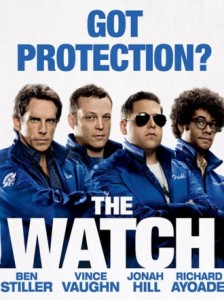 |
|
| The Watch | |
| Starring | Ben Stiller, Vince Vaughn, Jonah Hill, Richard Ayoade |
| Director: | Akiva Schaffer |
| Writer: | Jared Stern, Seth Rogen, Evan Goldberg |
| Studio: | 20th Century Fox |
| Release Date: | July 27, 2012 |
When Evan’s (Stiller) co-worker is found dead, Evan responds the only way he can–by forming a Neighborhood Watch group to find the killer. Joined by high school dropout and failed police candidate Franklin (Hill), British horndog Jamarcus (Ayoade), and party-guy construction worker Bob (Vaughn) the foursome uncover an invasion plot by extra terrestrials that threatens their small Ohio town.
As a fan of the three of the four stars (I’d not heard of Ayoade before this film) I ignored the word of mouth on The Watch and gave it a try. The Vaughn/Stiller team-up led to big laughs in Dodgeball and I hoped for a similar experience here. Surely enough, neither actor strays far from their wheelhouse–how often have we seen Stiller play a neurotic, pent-up suburbanite who can’t tell his loved ones about a personal failure? And once again Vaughn is playing the carefree party-guy who both parties like a college student and yet is also a devoted family man. These actors have had huge successes playing these exact characters, and they play it safe here. It’s a smart choice–all the film’s laughs come from these two characters and their opposing view of the group.
The other two Watch members are not as amusing. Hill once again plays a somewhat socially awkward sidekick. It worked for him well in Superbad and Forgetting Sarah Marshall, but it was disappointing to see him again playing the same character. All of Franklin’s dialogue has an ad-libbed feel that would work in any film Hill has appeared, and becomes less funny and more sad every time I see it. Avoade’s Jamarcus makes little impression as a British divorce. His character is important to the plot, but Avoade never escapes the shadow of his more famous co-stars.
The result is a highly uneven film. While ostensibly about an alien invasion, the first two-thirds of the film are really about these characters and their interactions. We also see Evan and Bob having trouble with the women in their lives, Evan’s marriage strained, Bob’s daughter partying too hard with a boy in school. These parts of the film are full of raunchy laughs and hard-R rated dick jokes, several of which were laugh-out-loud funny.
But when the film finally has to turn to the overarching plot it fails completely. It was a mistake to make this film about an alien invasion; the film has neither the budget nor the inclination to tell a good story about evil E.T.s. The film’s entire third act when the invasion comes to the fore is a painful exercise in banality.
Overall I give this film a mild not recommend. There are laughs to be had in this movie, but the three leads have all had bigger laughs in better films, and only Stiller and Vaughn die-hards need to Watch this for the few funny moments.
February 2, 2013 Posted by Arnie C | Movies, Now Playing Podcast, Reviews | Alien Invasion, Ben Stiller, Comedy, Movie, Now Playing, Review, Vince Vaughn | Comments Off on Movie Review: The Watch
-
Archives
- February 2021 (1)
- January 2021 (1)
- December 2020 (1)
- November 2020 (3)
- October 2020 (2)
- September 2020 (1)
- August 2020 (2)
- July 2020 (1)
- June 2020 (1)
- May 2020 (1)
- April 2020 (3)
- March 2020 (2)
-
Categories
-
RSS
Entries RSS
Comments RSS
Site info
Venganza Media GazetteTheme: Andreas04 by Andreas Viklund. Get a free blog at WordPress.com.

